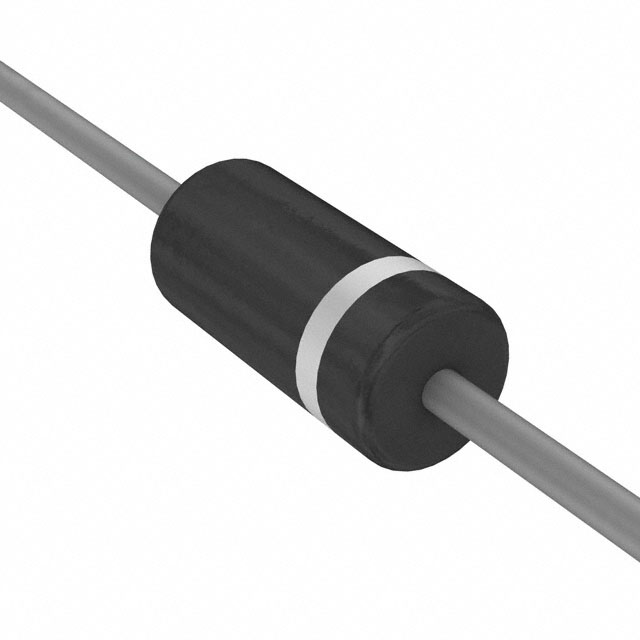Viz Specifikace pro podrobnosti o produktu.

1N5062GPHE3/73
Product Overview
Category
The 1N5062GPHE3/73 belongs to the category of semiconductor diodes.
Use
It is commonly used in rectification and voltage regulation applications.
Characteristics
- Forward Voltage: 1V
- Reverse Voltage: 100V
- Current Rating: 1A
- Fast Switching Speed
- Low Leakage Current
Package
The 1N5062GPHE3/73 is typically available in a DO-41 package.
Essence
This diode serves as a crucial component in electronic circuits for converting alternating current (AC) to direct current (DC).
Packaging/Quantity
It is usually packaged in reels or tubes, with quantities varying based on manufacturer specifications.
Specifications
- Forward Voltage: 1V
- Reverse Voltage: 100V
- Maximum Continuous Forward Current: 1A
- Operating Temperature Range: -65°C to +175°C
- Storage Temperature Range: -65°C to +175°C
Detailed Pin Configuration
The 1N5062GPHE3/73 has two pins, anode and cathode, which are identified by their physical orientation within the DO-41 package.
Functional Features
- Efficient rectification of AC to DC
- Fast switching speed for rapid response in electronic circuits
- Low forward voltage drop for minimal power loss
Advantages
- High reliability and durability
- Compact size for space-constrained applications
- Suitable for high-frequency operations
Disadvantages
- Limited reverse voltage tolerance compared to other diodes
- Sensitive to overvoltage conditions
Working Principles
The 1N5062GPHE3/73 operates based on the principle of unidirectional conduction, allowing current flow in one direction while blocking it in the reverse direction. This enables efficient rectification and voltage regulation in electronic circuits.
Detailed Application Field Plans
Power Supplies
The diode can be used in various power supply designs to convert AC input to DC output, ensuring stable and regulated power delivery.
Signal Demodulation
In communication systems, the diode facilitates the demodulation of amplitude-modulated (AM) signals, extracting the original signal from the carrier wave.
Voltage Regulation
By incorporating the diode into voltage regulator circuits, consistent and regulated DC voltage levels can be achieved for powering electronic devices.
Detailed and Complete Alternative Models
- 1N4001: Similar characteristics and package, suitable for general-purpose rectification
- 1N5819: Higher reverse voltage rating, ideal for applications requiring greater voltage tolerance
- 1N4148: Faster switching speed, suitable for high-frequency applications
In conclusion, the 1N5062GPHE3/73 semiconductor diode offers reliable rectification and voltage regulation capabilities, making it a valuable component in various electronic circuits.
Word Count: 411
Seznam 10 běžných otázek a odpovědí souvisejících s aplikací 1N5062GPHE3/73 v technických řešeních
What is the 1N5062GPHE3/73 used for?
- The 1N5062GPHE3/73 is a rectifier diode commonly used in power supply and voltage regulation applications.
What is the maximum forward current rating of the 1N5062GPHE3/73?
- The maximum forward current rating of the 1N5062GPHE3/73 is 3A.
What is the maximum reverse voltage rating of the 1N5062GPHE3/73?
- The maximum reverse voltage rating of the 1N5062GPHE3/73 is 200V.
Can the 1N5062GPHE3/73 be used in high-frequency applications?
- Yes, the 1N5062GPHE3/73 can be used in high-frequency applications due to its fast switching characteristics.
Is the 1N5062GPHE3/73 suitable for use in automotive electronics?
- Yes, the 1N5062GPHE3/73 is suitable for use in automotive electronics due to its rugged construction and reliability.
What is the typical forward voltage drop of the 1N5062GPHE3/73?
- The typical forward voltage drop of the 1N5062GPHE3/73 is around 1V at a forward current of 3A.
Does the 1N5062GPHE3/73 require a heatsink for operation?
- It is recommended to use a heatsink when operating the 1N5062GPHE3/73 at high currents or in elevated temperature environments.
Can the 1N5062GPHE3/73 be used in bridge rectifier configurations?
- Yes, the 1N5062GPHE3/73 can be used in bridge rectifier configurations for converting AC to DC.
What are the typical applications of the 1N5062GPHE3/73 in power supplies?
- The 1N5062GPHE3/73 is commonly used in linear and switch-mode power supplies, battery chargers, and voltage regulators.
Is the 1N5062GPHE3/73 RoHS compliant?
- Yes, the 1N5062GPHE3/73 is RoHS compliant, making it suitable for use in environmentally conscious designs.

